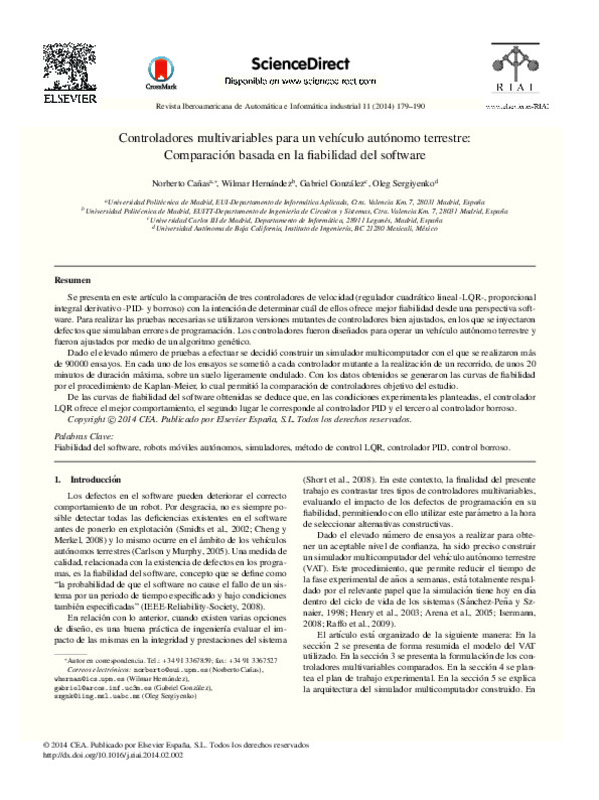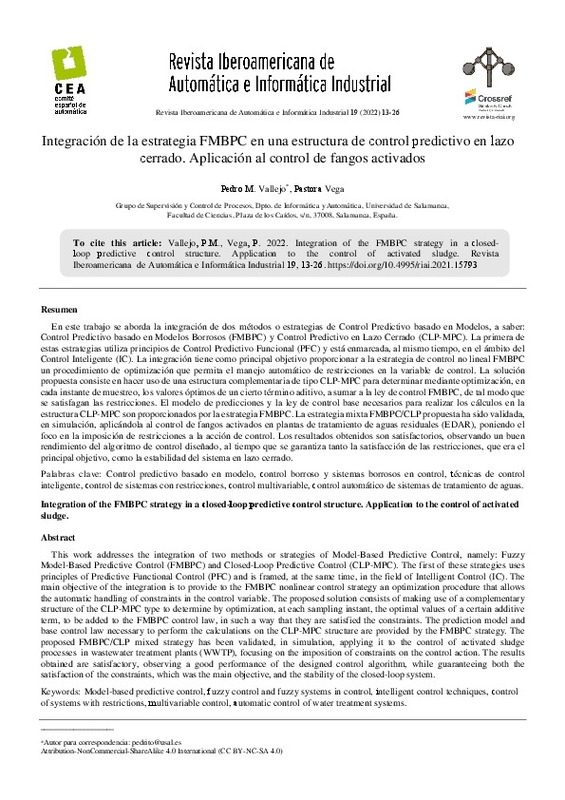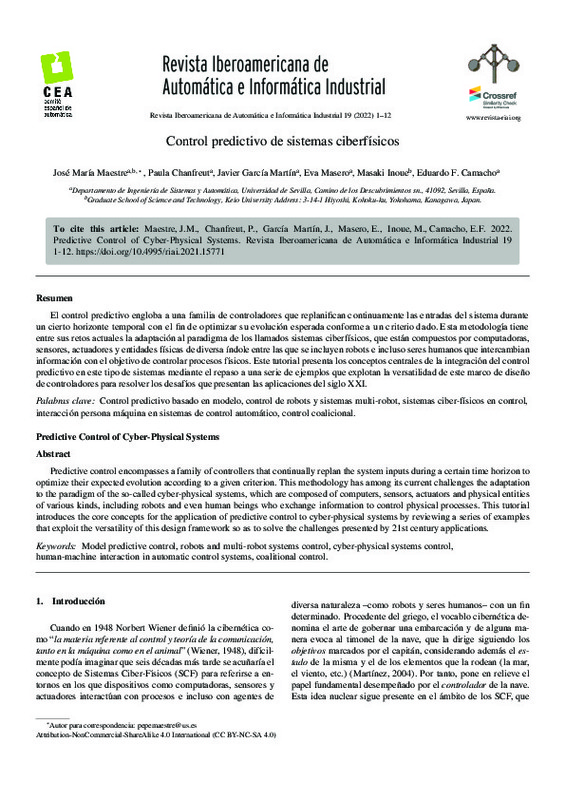JavaScript is disabled for your browser. Some features of this site may not work without it.
Buscar en RiuNet
Listar
Mi cuenta
Estadísticas
Ayuda RiuNet
Admin. UPV
Controladores multivariables para un vehículo autónomo terrestre: Comparación basada en la fiabilidad del software
Mostrar el registro sencillo del ítem
Ficheros en el ítem
| dc.contributor.author | Cañas, Norberto
|
es_ES |
| dc.contributor.author | Hernández, Wilmar
|
es_ES |
| dc.contributor.author | González, Gabriel
|
es_ES |
| dc.contributor.author | Sergiyenko, Oleg
|
es_ES |
| dc.date.accessioned | 2020-05-22T18:47:39Z | |
| dc.date.available | 2020-05-22T18:47:39Z | |
| dc.date.issued | 2014-04-13 | |
| dc.identifier.issn | 1697-7912 | |
| dc.identifier.uri | http://hdl.handle.net/10251/144182 | |
| dc.description.abstract | [ES] Se presenta en este artículo la comparación de tres controladores de velocidad (regulador cuadrático lineal-LQR-, proporcional integral derivativo-PID-y borroso) con la intención de determinar cuál de ellos ofrece mejor fiabilidad desde una perspectiva software. Para realizar las pruebas necesarias se utilizaron versiones mutantes de controladores bien ajustados, en los que se inyectaron defectos que simulaban errores de programación. Los controladores fueron diseñados para operar un vehículo autónomo terrestre y fueron ajustados por medio de un algoritmo genético.Dado el elevado número de pruebas a efectuar se decidió construir un simulador multicomputador con el que se realizaron más de 90000 ensayos. En cada uno de los ensayos se sometió a cada controlador mutante a la realización de un recorrido, de unos 20 minutos de duración máxima, sobre un suelo ligeramente ondulado. Con los datos obtenidos se generaron las curvas de fiabilidad por el procedimiento de Kaplan-Meier, lo cual permitió la comparación de controladores objetivo del estudio.De las curvas de fiabilidad del software obtenidas se deduce que, en las condiciones experimentales planteadas, el controlador LQR ofrece el mejor comportamiento, el segundo lugar le corresponde al controlador PID y el tercero al controlador borroso. | es_ES |
| dc.description.abstract | [EN] In this paper, three multivariable speed controllers (linear quadratic regulator-LQR, proportional integral derivative - PID, and Fuzzy) were compared with each other to find which one has the best software reliability. The reliability tests were conducted on perturbed controllers with injected faults, simulating typical programmer errors. These controllers were designed to operate in an autonomous ground vehicle, and they were tuned by using a genetic algorithm. Given the large number of tests to be performed it was decided to build a multi-computer simulator in which they were carried out more than 90000 essays. In each of the trials, the perturbed controllers were subjected to a tour of approximately 20 minutes on a slightly wavy ground. With the obtained data, the reliability curves were elaborated by means of the Kaplan-Meier procedure, and this allowed their comparison which was the aim of this research. Under the observed experimental conditions, the LQR controller provides the best behavior, the second position belongs to the PID controller, and the third one to the fuzzy controller. | es_ES |
| dc.description.sponsorship | Esta investigación ha sido financiada por el Ministerio de Ciencia e Innovación (MICINN) de España bajo el proyecto de investigación TEC2010-17429. | es_ES |
| dc.language | Español | es_ES |
| dc.publisher | Elsevier | es_ES |
| dc.relation.ispartof | Revista Iberoamericana de Automática e Informática industrial | es_ES |
| dc.rights | Reserva de todos los derechos | es_ES |
| dc.subject | Software reliability | es_ES |
| dc.subject | Autonomous mobile robots | es_ES |
| dc.subject | Simulators | es_ES |
| dc.subject | LQR controller | es_ES |
| dc.subject | PID controller | es_ES |
| dc.subject | Fuzzy controller | es_ES |
| dc.subject | Fiabilidad del software | es_ES |
| dc.subject | Robots móviles autónomos | es_ES |
| dc.subject | Simuladores | es_ES |
| dc.subject | Método de control LQR | es_ES |
| dc.subject | Controlador PID | es_ES |
| dc.subject | Control borroso | es_ES |
| dc.title | Controladores multivariables para un vehículo autónomo terrestre: Comparación basada en la fiabilidad del software | es_ES |
| dc.title.alternative | Multivariable controllers for an autonomous ground vehicle: comparison based on software reliability | es_ES |
| dc.type | Artículo | es_ES |
| dc.identifier.doi | 10.1016/j.riai.2014.02.002 | |
| dc.relation.projectID | info:eu-repo/grantAgreement/MICINN//TEC2010-17429/ES/SENSOR ROBUSTO/ | es_ES |
| dc.rights.accessRights | Abierto | es_ES |
| dc.description.bibliographicCitation | Cañas, N.; Hernández, W.; González, G.; Sergiyenko, O. (2014). Controladores multivariables para un vehículo autónomo terrestre: Comparación basada en la fiabilidad del software. Revista Iberoamericana de Automática e Informática industrial. 11(2):179-190. https://doi.org/10.1016/j.riai.2014.02.002 | es_ES |
| dc.description.accrualMethod | OJS | es_ES |
| dc.relation.publisherversion | https://doi.org/10.1016/j.riai.2014.02.002 | es_ES |
| dc.description.upvformatpinicio | 179 | es_ES |
| dc.description.upvformatpfin | 190 | es_ES |
| dc.type.version | info:eu-repo/semantics/publishedVersion | es_ES |
| dc.description.volume | 11 | es_ES |
| dc.description.issue | 2 | es_ES |
| dc.identifier.eissn | 1697-7920 | |
| dc.relation.pasarela | OJS\9458 | es_ES |
| dc.contributor.funder | Ministerio de Ciencia e Innovación | es_ES |
| dc.description.references | Albertos, P., Sala, A., 2004. Multivariable Control Systems: An Engineering Approach. Springer, pp. 303-309. | es_ES |
| dc.description.references | Albus, J.S., Aug. 1985. Hierarchical Control for Robots and Teleoperators. En: IEEE Workshop on Intelligent Control. pp. 1-14. | es_ES |
| dc.description.references | Albus, J.S., McCain, H.G., Lumia, R., 1989. NASA/NBS Standard Reference Model for Telerobot Control System Architecture (NASREM). NIST Technical note 1235. Tech. rep., National Institute of Standards and Technology. | es_ES |
| dc.description.references | Arena, P., Fortuna, L., Frasca, M., Turco, G.L., Patané, L., Russo, R., 2005. A new simulation tool for action-oriented perception systems. En: Proceedings of 10th IEEE Conference on Emerging Technologies and Factory Automation . pp. 571-577. | es_ES |
| dc.description.references | Arkin, R.C., Mar. 1987. Motor Schema Based Navigation for a Movile Robot. En: Proceedings of the IEEE International Conference on Robotics and Automation. pp. 264-271. | es_ES |
| dc.description.references | Bensalem, S., Gallien, M., Ingrand, F., Kahloul, I., Thanh-Hung, N., 2009. Designing Autonomous Robots. IEEE Robotics and Automation Magazine 16 (1), 67-77. | es_ES |
| dc.description.references | Brooks, R.A., Mar. 1986. A Robust Layered Control System for a Movile Robot. IEEE Journal of Robotics and Automation RA-2 (1), 14-23. | es_ES |
| dc.description.references | Burns, A., Wellings, A., 1997. Real-Time Systems and Programming Languages. Addison-Wesley, pp. 422-424. | es_ES |
| dc.description.references | Burns, R.S., 2001. Advanced Control Engineering. Butterwoth-Heinemann, pp. 326-347. | es_ES |
| dc.description.references | Carlson, J., Murphy, R.R., Jun. 2005. How UGVs Physically Fail in the Field. IEEE Transaction on Robotics 21 (3), 423-437. | es_ES |
| dc.description.references | Cheng, T.Y., Merkel, R., Jun. 2008. An Upper Bound on Software Testing Effectiveness. ACM Transcations on Software Engineering and Methodology 17 (3), 16:1-16:27. | es_ES |
| dc.description.references | Fay, M.P., Shaw, P.A., Aug. 2010. Exact and Asymptotic Weighted Logrank Test for Interval Censored Data: The Interval R Package. Journal of Statistical Software 36 (2), 1-34. | es_ES |
| dc.description.references | Fossen, T.I., 1999. Guidance and Control of Ocean Vehicles. John Wiley & Sons, pp. 5-28. | es_ES |
| dc.description.references | Franklin, G.F., Powell, J.D., Workman, M.L., 1990. Digital Control of Dynamic Systems. Addison Wesley, Ch. 2. | es_ES |
| dc.description.references | gon Roh, S., Yang, K.W., Park, J.H., Moon, H., Kim, H.-S., Lee, H., Choi, H. R., Apr. 2009. A Modularized Personal Robot DRP I: Design and Implementation. IEEE Transaction on Robotics 25 (2), 414-425. | es_ES |
| dc.description.references | Gong, Y., Xu, W., Li, X., Nov. 2003. An Expression's Single Fault Model and the Testing Methods. En: Proceedings of the 12th Asian Test Symposium (ATS’03). | es_ES |
| dc.description.references | Good, P.I., Hardin, J.W., 2003. Common Errors in Statistics (and How to Avoid Them). John Wiley & Sons, Ch. 7, p. 100. | es_ES |
| dc.description.references | Goodwin, G.C., Graebe, S.F., Salgado, M.E., Jan. 2001. Control System Design. Prentice-Hall, pp. 672-674. | es_ES |
| dc.description.references | Henry, J., Stiff, J.C., Shirar, A.J., 2003. Assessing and Improving Testing of Real-time Software using Simulation. En: Proceedings of the 36th Annual Simulation Symposium. pp. 266-272. | es_ES |
| dc.description.references | Hernandez, W., Canas, N., Nov. 2011. Non-linear Control of an Autonomous Ground Vehicle. En: Proceedings of the 37th Annual Conference of the IEEE Industrial Electronics Society (IECON-2011). IEEE Industrial Electronicas Society, pp. 2601-2606. | es_ES |
| dc.description.references | Hydromechanics-Subcommittee, Apr. 1950. Nomenclature for Treating the Motion of a Submerged Body Through a Fluid. Tech. Rep. 1-5, The Society of Naval Architects and Marine Engineers (SNAME), New York (USA). | es_ES |
| dc.description.references | IEEE-Reliability-Society, Mar. 2008. IEEE Recommended Practice on Software Reliability. IEEE Std 1633-2008. Tech. rep., IEEE Reliability Society, 3 Park Avenue, New York, USA. | es_ES |
| dc.description.references | Isermann, R., 2008. Mechatronics systems-Innovative products with embedded control. Control Engineering Practice 16, 14-29. | es_ES |
| dc.description.references | Jeffrey, D., Gupta, N., Gupta, R., 2008. Fault localization using value replacement. En: Proceedings of the 2008 international symposium on Software testing and analysis (ISSTA ‘08). pp. 167-177. | es_ES |
| dc.description.references | Kleinbaum, D.G., Klein, M., 2005. Survival Analysis. A Self-Learning Text. Springer, Ch. 2. | es_ES |
| dc.description.references | Lau, M.F., Yu, Y.T., Jul. 2005. An Extended Fault Class Hierarchy for Specification-Based Testing . ACM Transactions on Software Engineering and Methodology (TOSEM) 14 (3), 247-276. | es_ES |
| dc.description.references | Lewin, D., Parag, A., 2003. A constrained genetic algorithm for decentralized control system structure selection and optimization. Automatica 39, 1801-1807. | es_ES |
| dc.description.references | McLinn, J., Jan. 2011. A short history of reliability. The Journal of the Reliability Information Analysis Center. | es_ES |
| dc.description.references | Montgomery, D.C., Runger, G.C., 2003. Applied Statistics and Probability for Engineers, 3rd Edición. John Wiley & Sons, Ch. 9.2.2. | es_ES |
| dc.description.references | Nilsson, N.J., Fikes, R.E., Oct. 1970. STRIPS: A New Approach to the Application ot Theorem Proving to Problem Solving. Technical note 43. SRI Project 8259. Tech. rep., Artificial Intelligence Group. Standford Research Institute. | es_ES |
| dc.description.references | Passino, K.M., Yurkovich, S., 1998. Fuzzy Control. Addison Wesley, pp. 58-73. | es_ES |
| dc.description.references | Raffo, G.V., Normey-Rico, J.E., Rubio, F.R., Kerlber, C.R., Jan. 2009. Control Predictivo en Cascada de un Vehículo Autónomo. Revista Iberoamericana de Automática e Informática Industrial 6 (1), 63-71. | es_ES |
| dc.description.references | Saleh, J., Marais, K., 2006. Highlights from the early (and pre-) history of reliability engineering. Reliability Engineering and System Safety 91, 249-256. | es_ES |
| dc.description.references | Sánchez-Peña, R.S., Sznaier, M., 1998. Robust Systems. Theory and Applications. John Wiley and Sons, Ch. 1.1.2. | es_ES |
| dc.description.references | Shooman, M.L., 2002. Reliability of Computer Systems and Networks. John Wiley & Sons, pp. 203-205. | es_ES |
| dc.description.references | Short, M., Pont, M.J., Fang, J., 2008. Assessment of performance and dependability in embedded control systems: Methodology and case study. Control Engineering Practice 16, 1293-1307. | es_ES |
| dc.description.references | Smidts, C., Huang, X., Widmaier, J.C., 2002. Producing reliable software: an experiment. The Journal of Systems and Software 61, 213-224. | es_ES |
| dc.description.references | Tian, J., 2005. Software Quality Engineering. Testing, Quality Assurance and Quantifiable Improvement. John Wiley and Sons, Ch. 22.1-22.4, pp. 371-380. | es_ES |
| dc.description.references | Xie, M., Dai, Y.-S., Poh, K.-L., 2004. Computing Systems Reliability. Models and Analysis. Kluwer Academic Publishers, Ch. 4. | es_ES |











